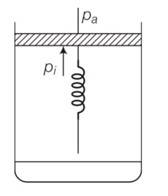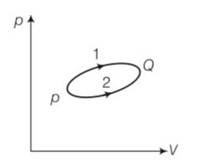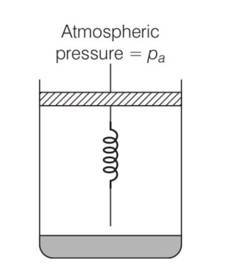Thermodynamics
Get insights from 324 questions on Thermodynamics, answered by students, alumni, and experts. You may also ask and answer any question you like about Thermodynamics
Follow Ask QuestionQuestions
Discussions
Active Users
Followers
New answer posted
4 months agoContributor-Level 10
This is a short answer type question as classified in NCERT Exemplar
For adiabatic change process we know
P1V1y= P2V2y
P (V+ )y = (P+ )Vy
PVy (1+ ) y=p (1+ )Vy
PVy (1+ ) PVy (1+ )
Y
dV=
hence work done increasing the pressure from P1 to P2
W=
=
W=
New answer posted
4 months agoContributor-Level 10
This is a short answer type question as classified in NCERT Exemplar
Height of stairs h= 10m
Energy produced by burning 1 kg of fat = 7000Kcal
Energy produced by burning 5kg of fat = 5
Energy utilised in going up and down one time
= mgh + =
=
= 9000J= 9000/4.2=3000/1.4cal
Number of times, the person has to go up and down the stairs
= = 16.3 times
New answer posted
4 months agoContributor-Level 10
This is a short answer type question as classified in NCERT Exemplar
Temperature of the source T1= 500K and sink T2= 300K
Work done W= 1000J
Efficiency of Carnot engine = 1-T2/T1= 1-300/500= 200/500= 2/5
Efficiency = W/Q1
So Q1= W/efficiency = 1000
New answer posted
4 months agoContributor-Level 10
This is a short answer type question as classified in NCERT Exemplar
During driving temperature of the gas increases while volume remains constant. So according charle's law, at constant volume V.
Pressure is directly proportional to temperature. Therefore pressure of gas increases.
New answer posted
4 months agoContributor-Level 10
This is a short answer type question as classified in NCERT Exemplar
Yes during adiabatic compression the temperature of a gas increases while no heat is
In adiabatic compression dQ=0
From the first law of thermodynamics dU= dQ-dW
dU=-dW
in compression work is done on the gas i.e work done is negative
dU=positive
hence internal energy of the gas increases due to which its temperature increases.
New answer posted
4 months agoContributor-Level 10
This is a short answer type question as classified in NCERT Exemplar
If a refrigerator's doors is kept open, then room will become hot, because amount of heat removed would be less than the amount of heat released in the room.
New answer posted
4 months agoContributor-Level 10
This is a short answer type question as classified in NCERT Exemplar
For path1
Heat Q1= 1000J
Work done =W1
For path 2
Work done W2= W1-100
As change in internal energy is same
dU=Q1-W1=Q2-W2
1000-W1=Q2-W1+100
Q2= 1000-100= 900J
New answer posted
4 months agoContributor-Level 10
This is a short answer type question as classified in NCERT Exemplar
Yes this is possible when the entire heat supplied to the system is utilised in expansion.
So its working against the surroundings.
New answer posted
4 months agoContributor-Level 10
This is a long answer type question as classified in NCERT Exemplar
(a) Initially the piston is in equilibrium Pi=Pa

(b) On supplying heat , the gas expands from Vo to Vi
so increase in volume of the gas =Vi-Vo
as the piston is of unit cross sectional area hence extension in the spring
x=
force exerted by the spring on the piston= F= kx= K(Vi - Vo)
hence final pressure =Pf =Pa +kx
= Pa+K ( )
(c) From first law of thermodynamics
dQ=dU+dW
dU=Cv(T-To) = Cv(T-To)
T=
Work done by the gas =pdV+ increase in PE of the spring
= Pa(V1-Vo) + x2
dQ=dU+dW
= Cv(T-To)+Pa(V-Vo)+ x2
= Cv(T-To)+Pa(v-Vo)+1/2 ( )2
New answer posted
4 months agoContributor-Level 10
This is a long answer type question as classified in NCERT Exemplar
Slope of the curve = f(V) , where V is the volume
Slope of P = f(V) curve at ((Po, V0 )= f(Vo)
Slope of adiabatic at (Po, V0 )= k(-Y)Vo-1-Y =-YPo/Vo
Now heat absorbed in the process P= f(V)
dQ=dU+dW= nCvdT+pdV
pV=nRT
T= pV/nR
T=
nCv
After solving we get
=
Heat is absorbed where dQ/dV>0 when gas expands
Hence YPo+Vof'(Vo)>0 or f'(Vo)>(-Y )
Taking an Exam? Selecting a College?
Get authentic answers from experts, students and alumni that you won't find anywhere else
Sign Up on ShikshaOn Shiksha, get access to
- 65k Colleges
- 1.2k Exams
- 687k Reviews
- 1800k Answers


